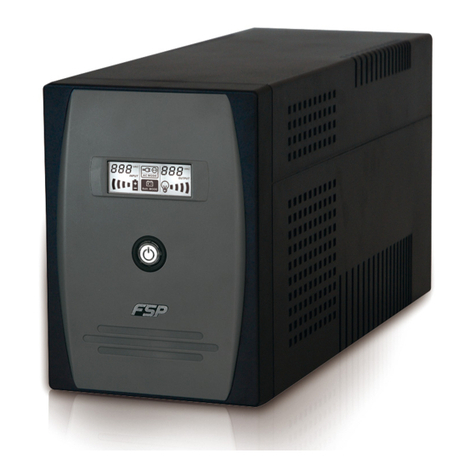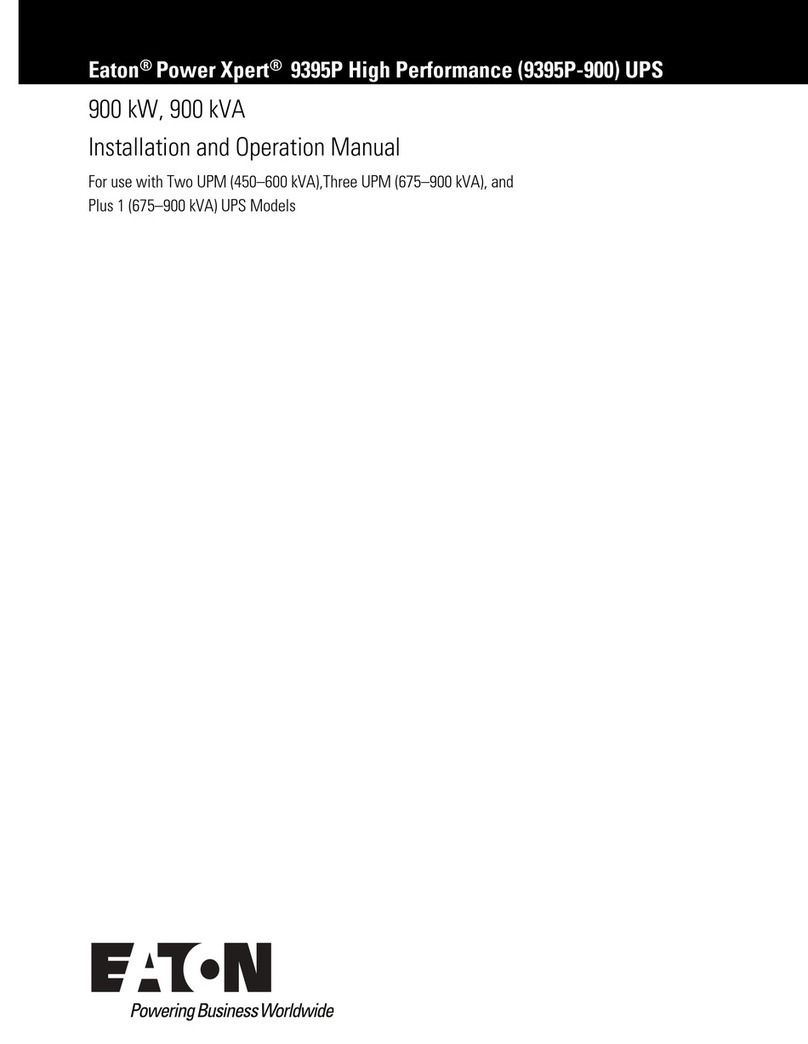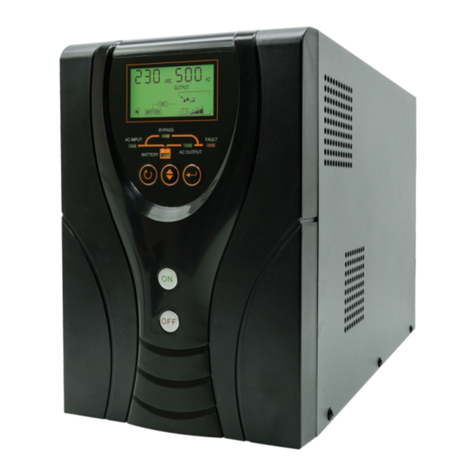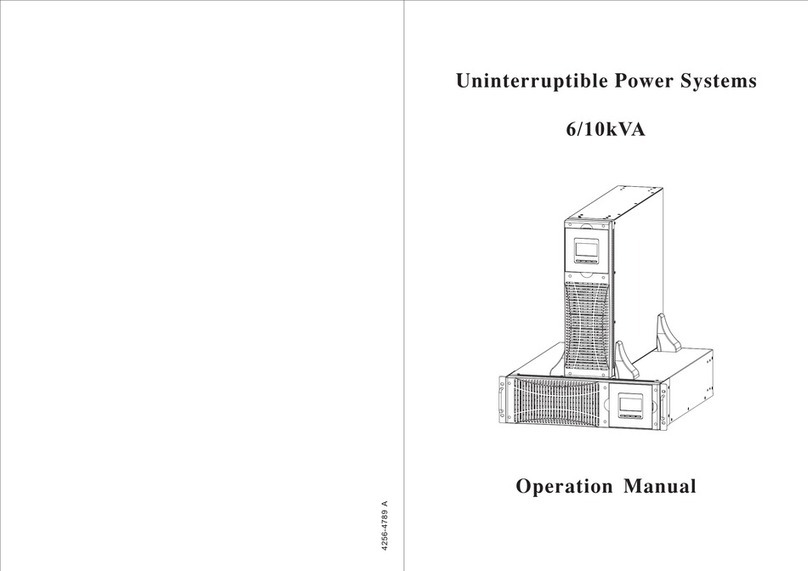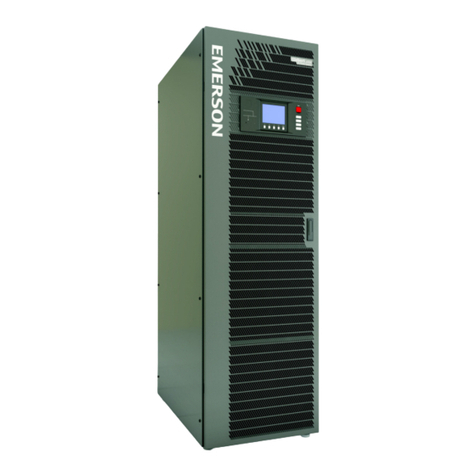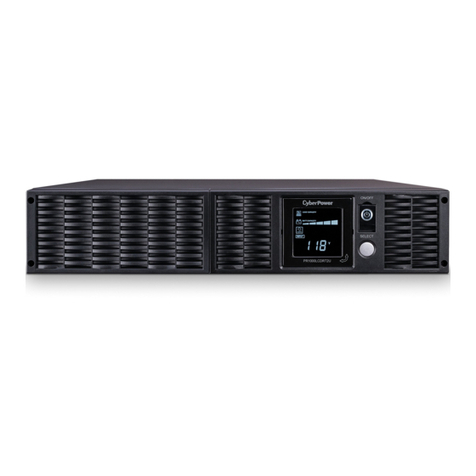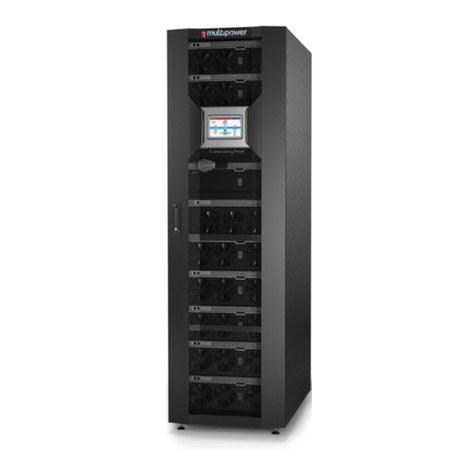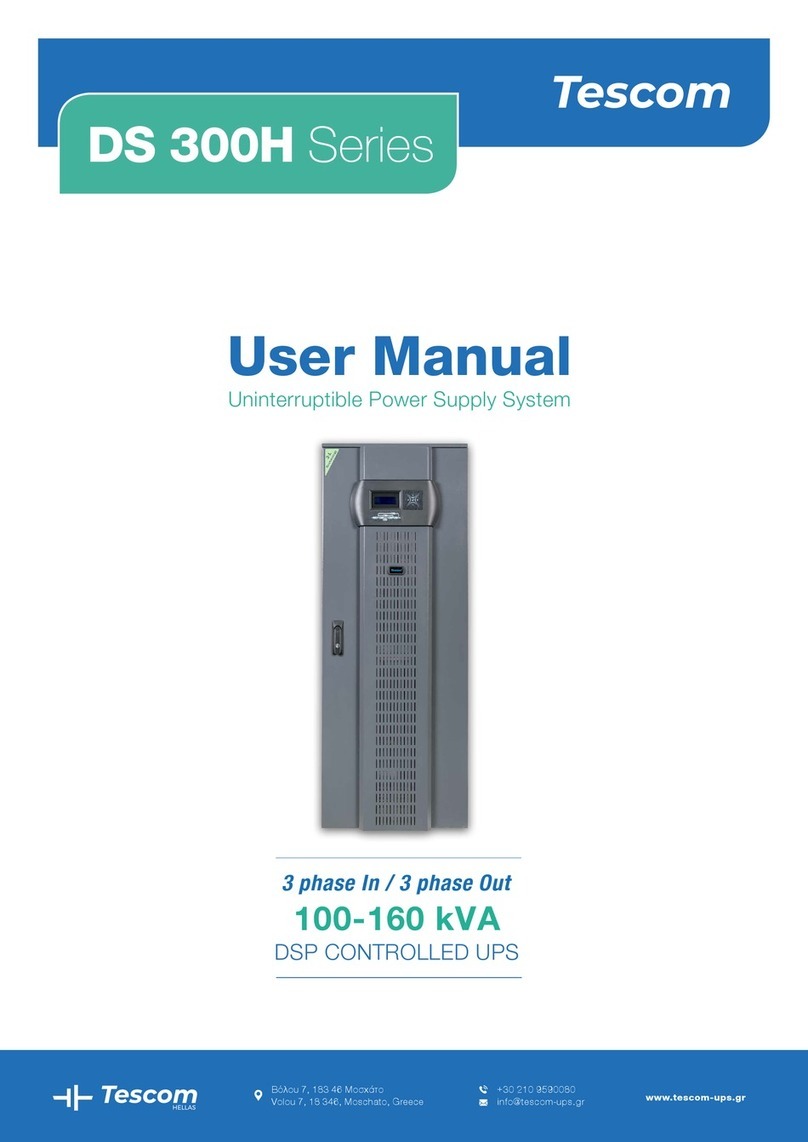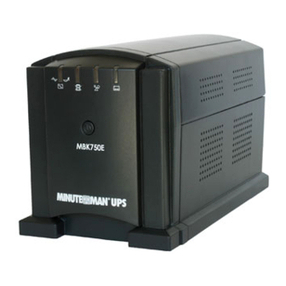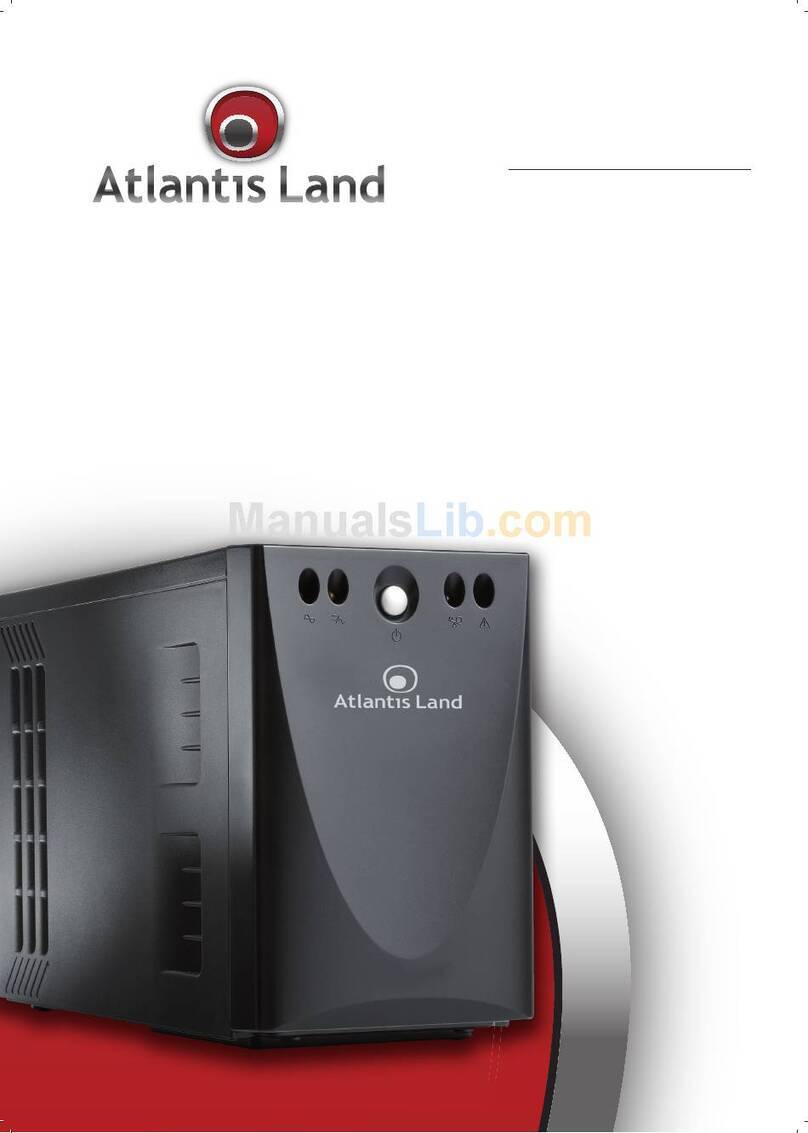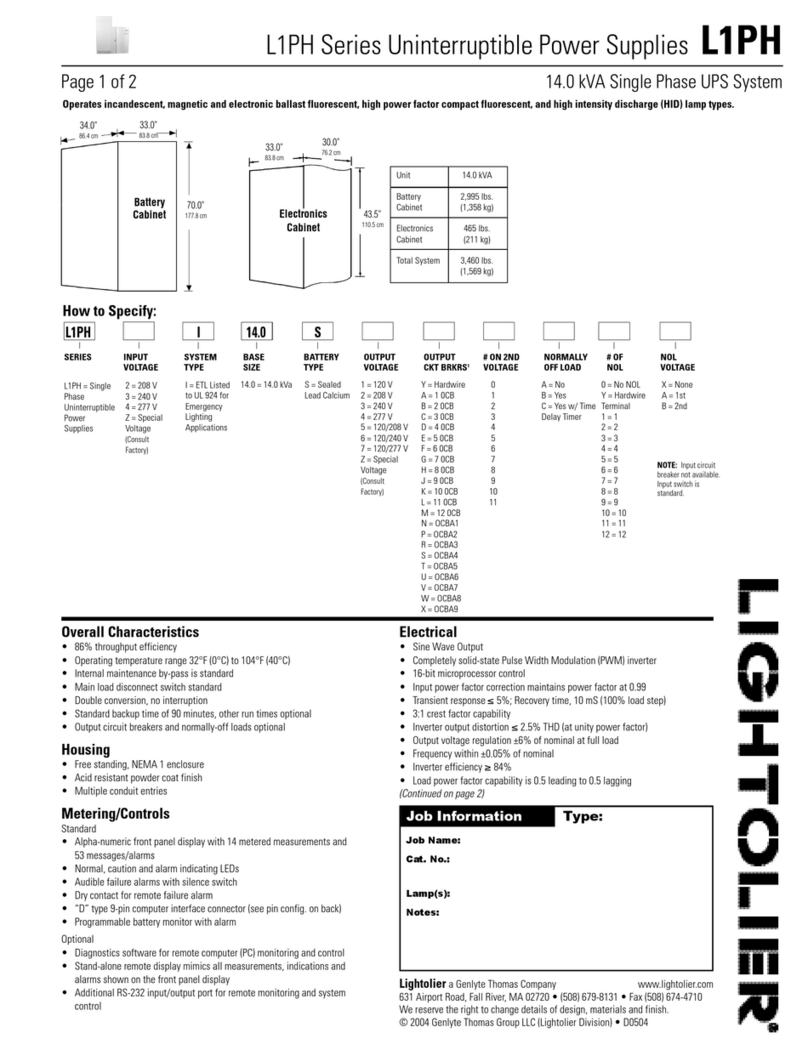Socomec Sicon DELPHYS MX elite User manual

Operating manual for
DELPHYS MX and DELPHYS MX elite
Uninterruptible Power Systems
with a basic control panel
UPS/NTA GB/DELMX_EXPC1C3C6.B
01/03/2005

UPS/NTA GB/DELMX_EXPC1C3C6.B page 1/39
Certificate of Warranty
The warranty conditions are stipulated in the sales contract, if not the following points
shall apply.
The manufacturer exclusively guarantees his own products against any defect in
construction or operation arising from faulty design, materials or workmanship
according to the conditions set down below.
The manufacturer, at his discretion, is entitled to adapt his product in order to comply
with the warranty or replace the faulty parts. The manufacturer’s warranty does not
apply in the following cases :
- Defects arising either from designs or parts imposed or supplied by the Purchaser.
- Failure due to fortuitous circumstances or force majeure.
- Replacements or repairs resulting from normal wear of units and machinery,
- Damage or injuries caused by negligence, lack of inspection or maintenance, or
improper use of the products.
The period of validity of the warranty may never exceed 12 months after delivery.
Replacements, repairs or modifications of parts during the warranty period cannot
extend the duration of the warranty.
For these stipulations to be valid, the Purchaser must, within a maximum of 8 days
beyond which the warranty lapses, expressly inform the Manufacturer of the faulty
design, or the material or manufacturing defect, stating in detail the grounds for his
complaint.
Defective parts replaced free of charge by the Manufacturer are to be put at his
disposal, so that he may become the sole owner.
The warranty legally ceases if the Purchaser has, of his own initiative, undertaken
modifications or repairs on the Manufacturer’s products without the written consent of
the latter.
The Manufacturer’s liability is limited to the obligations as defined herein (repair or
replacement), all other items of damage being formally excluded.
The Purchaser is liable for taxes or duties of any kind in compliance with either the
European regulations, or those of the country of import or transit.

UPS/NTA GB/ DELMX_EXPC1C3C6.B page 2
FOREWORD
We thank you for the trust you have in our Uninterruptible Power Systems.
This equipment is fitted with up to date technology. Rectifier and inverter subsets are provided with
power semiconductors (IGBT) including a digital micro-controller.
Our equipment complies with standard CEI EN 62040-2.
CAUTION: “This is a product for restricted sales distribution to informed partners. Installation
restrictions or additional measures may be needed to prevent disturbances”.
SAFETY REQUIREMENTS
Using conditions:
Do read carefully these operation instructions before using the UPS and comply with the safety notes
mentioned.
Whatever the repairs, they must be made only by authorised staff, who have been suitably trained. It is
recommended that the ambient temperature and humidity of the UPS environment are maintained
below the values specified by the manufacturer.
This equipment meets the requirements of the European directives applied to this product. As a
consequence it is labelled as follows:
REGULATIONS CONCERNED WITH ENVIRONMENTAL ISSUES
Recycling of electrical products and equipment.
Provision is made in European countries to break up and recycle materials making up the system. The
various components must be disposed of in accordance with the legal provisions in force in the country
where the system is installed.
Battery wastes
Used batteries are considered as toxic wastes. It is therefore essential to entrust them solely and
exclusively to firms specialised in their recycling. They can not be treated with other industrial or
household wastes, as set out in local regulations in force.

UPS/NTA GB/ DELMX_EXPC1C3C6.B page 3
CONTENTS
SAFETY REQUIREMENTS................................................................................................................................................ 2
1. GENERAL.................................................................................................................................................................... 5
2. PURPOSE AND UPS COMPOSITION..................................................................................................................... 5
3. SAFETY........................................................................................................................................................................ 6
4. LAYOUT OF SWITCHES.......................................................................................................................................... 7
5. CONTROL PANEL WITH MIMIC PANEL............................................................................................................ 7
5.1. OVERVIEW............................................................................................................................................................. 7
5.2. LCD DISPLAY ........................................................................................................................................................ 8
5.3. LUMINOUS STATUS BAR ......................................................................................................................................... 9
5.4. CONTRAST SETTING ............................................................................................................................................... 9
6. SINGLE UNITS WITH BYPASS............................................................................................................................. 10
6.1. STANDARD BASIC SCHEMES ................................................................................................................................. 10
6.2. MEANING OF THE PICTOGRAMS............................................................................................................................ 10
6.3. MIMIC PANEL DESCRIPTION ................................................................................................................................. 11
6.4. DESCRIPTION OF THE LUMINOUS STATUS BAR...................................................................................................... 11
6.5. MENU STRUCTURE............................................................................................................................................... 12
7. OPERATING A SINGLE UPS ................................................................................................................................. 13
7.1. STARTING UP THE UPS ........................................................................................................................................ 13
7.2. LOAD TRANSFER FROM INVERTER TO MAINS........................................................................................................ 13
7.3. LOAD TRANSFER FROM MAINS TO INVERTER........................................................................................................ 14
7.4. UPS SHUTDOWN WITH TRANSFER TO THE MAINTENANCE BYPASS ....................................................................... 14
7.5. OPERATING MODE................................................................................................................................................ 14
8. MODULAR SYSTEMS............................................................................................................................................. 15
8.1. MODULAR SYSTEMS WITH TWO REDUNDANT UPS UNITS..................................................................................... 15
8.2. MODULAR SYSTEMS WITH TWO NON REDUNDANT UPS UNITS ............................................................................. 15
8.3. MODULAR SYSTEMS WITH THREE UPS UNITS OR MORE ....................................................................................... 16
8.4. MEANING OF THE PICTOGRAMS............................................................................................................................ 16
8.5. MIMIC PANEL DESCRIPTION ................................................................................................................................. 17
8.6. DESCRIPTION OF THE LUMINOUS STATUS BAR...................................................................................................... 17
8.7. STRUCTURE OF THE SYSTEM RELATED MENU ....................................................................................................... 18
8.8. STRUCTURE OF THE UNIT RELATED MENUS (UNIT)............................................................................................... 19
9. OPERATING THE MODULAR SYSTEM............................................................................................................. 20
9.1. STARTING UP THE MODULAR SYSTEM .................................................................................................................. 20
9.2. LOAD TRANSFER FROM INVERTER TO MAINS........................................................................................................ 21
9.3. LOAD TRANSFER FROM MAINS TO INVERTER........................................................................................................ 21
9.4. SWITCHING TO MAINTENANCE BYPASS -SHUTDOWN OF THE SYSTEM .................................................................. 21
9.4.1. System with two redundant units.................................................................................................................... 21
9.4.2. System with two non redundant units or more than two parallel units.......................................................... 22
9.4.3. Shutdown of the units..................................................................................................................................... 22
9.5. OPERATION OF A UNIT.......................................................................................................................................... 22
9.5.1. Uncoupling a unit from the common busbar.................................................................................................. 22
9.5.2. Shutdown of a unit.......................................................................................................................................... 23
9.5.3. Unit switching on or coupling to the common busbar................................................................................... 23

UPS/NTA GB/ DELMX_EXPC1C3C6.B page 4
10. CENTRAL BYPASS SYSTEMS.......................................................................................................................... 24
10.1. STANDARD BASIC SCHEME................................................................................................................................... 24
10.2. MIMIC PANEL OF A MODULE (RECT.–BATT.–INV.)............................................................................................ 24
10.3. MIMIC PANEL DESCRIPTION ................................................................................................................................. 25
10.4. DESCRIPTION OF THE LUMINOUS STATUS BAR ON A MODULE ............................................................................... 25
10.5. STRUCTURE OF THE UNIT MENUS......................................................................................................................... 26
10.6. MIMIC PANEL OF THE CENTRAL BYPASS CABINET ................................................................................................ 27
10.7. MIMIC PANEL DESCRIPTION ................................................................................................................................. 27
10.8. DESCRIPTION OF THE LUMINOUS STATUS BAR ON THE CENTRAL BYPASS CABINET............................................... 27
10.9. STRUCTURE OF THE CENTRAL BYPASS CABINET MENU......................................................................................... 28
11. OPERATING THE CENTRAL BYPASS SYSTEM.......................................................................................... 29
11.1. USING.................................................................................................................................................................. 29
11.2. PRELIMINARY CONDITIONS .................................................................................................................................. 29
11.3. STARTING UP THE UPS ........................................................................................................................................ 29
11.4. LOAD TRANSFER FROM INVERTER TO MAINS........................................................................................................ 29
11.5. LOAD TRANSFER FROM MAINS TO INVERTER........................................................................................................ 30
11.6. UPS SHUTDOWN WITH SWITCHING TO THE MAINTENANCE BYPASS...................................................................... 30
12. COMMENTS CONCERNING THE MENUS.................................................................................................... 31
12.1. MENU MEASUREMENTS........................................................................................................................................ 31
12.2. MENU UPS COMMANDS ...................................................................................................................................... 31
12.3. MENU EVENT LOG ............................................................................................................................................... 31
12.4. BATTERY ............................................................................................................................................................. 32
12.4.1. Battery test information............................................................................................................................. 32
12.4.2. Conditions to start the battery test ............................................................................................................ 32
12.4.3. Test programming ..................................................................................................................................... 32
12.4.4. Starting the manual test............................................................................................................................. 32
12.5. UPS GENERAL DATA............................................................................................................................................ 33
12.5.1. Diagnostic codes ....................................................................................................................................... 33
12.5.2. UPS references.......................................................................................................................................... 33
12.5.3. Auxiliary inputs ......................................................................................................................................... 33
12.6. STATUS MENU...................................................................................................................................................... 33
12.6.1. UPS general status.................................................................................................................................... 33
12.6.2. List of STATUS for single units and modular systems .............................................................................. 34
12.6.3. List of STATUS for central bypass systems............................................................................................... 34
12.7. CLOCK................................................................................................................................................................. 35
12.8. CONFIGURATION.................................................................................................................................................. 35
12.8.1. Language................................................................................................................................................... 35
12.8.2. Buzzer........................................................................................................................................................ 36
12.8.3. Access code ............................................................................................................................................... 36
12.8.4. Local / Remote........................................................................................................................................... 37
12.9. JBUS LINK........................................................................................................................................................... 37
12.10. LIST OF ALARMS.............................................................................................................................................. 38
12.10.1. Display of activated alarms....................................................................................................................... 38
12.10.2. Resetting an alarm .................................................................................................................................... 38
12.10.3. List of alarms for single units and modular systems................................................................................. 38
12.10.4. List of alarms for central bypass systems.................................................................................................. 39
ABBREVIATIONS:
-UPS: Uninterruptible Power Systems
-LCD: Liquid Crystal Display
-SC: Static switch.
-CIM: Commissioning, Inspection and Maintenance Department.

Chapter 1 : General
UPS/NTA GB/ DELMX_EXPC1C3C6.B page 5
1. GENERAL
This document provides required information for operating DELPHYS MX and DELPHYS MX
elite systems. It describes the facilities offered on the control panels :
-Scrolling through the menus displayed
-Load transfer onto the automatic and/or maintenance bypass
-System start up or shutdown
The operating instructions refer to the most frequently used configurations, i.e. :
-Single UPS’s with bypass
-Modular systems
-Central bypass systems
2. PURPOSE AND UPS COMPOSITION
DELPHYS MX and DELPHYS MX elite provide :
- very low distortion and high power factor to the upstream power supply,
- voltage and frequency stability as well as continuity of supply to downstream loads –whatever the
outages or disturbances on the upstream power supply-.
The system is fitted with double conversion VFI-SS-111 technology.
When the upstream mains is present, the UPS acts as a stabilizer. In the event of a mains failure, it
acts as a source of electrical power. In such case, the required power is supplied by the battery,
which is kept charged when the mains is present.
DELPHYS MX and DELPHYS MX elite provide three-phase sinusoidal output. The UPS is
composed of :
-1 fully controlled three-phase rectifier of DBC type (Double Bridge Converter),
-1 three-phase inverter of S.V.M. type (Space Vector Modulation),
-1 static bypass to transfer the load automatically and without interruption to the mains,
-1 maintenance bypass which allows a seamless load transfer to the mains during maintenance
operations,
-1 battery,
-1 DC/DC converter for recharging the batteries,
-1 control panel made up of a mimic panel, an 8-line display and an intuitive user interface.

Chapter 1 : General
UPS/NTA GB/ DELMX_EXPC1C3C6.B page 6
3. SAFETY
CAUTION
The equipment can only be switched on or used if the following
conditions are fulfilled :
- electrical connections comply with the regulation in force (earth
bonding, appropriate protections and cross-section of cables)
- all means to comply with the protection index of the system are in
place, such as side panels, doors, glands, shields or whatever...).
ADVICE
- Carefully follow the instructions described in this manual.
- All handling must only be carried out by personnel who are suitably
trained.
CAUTION
Do not forget that even when the load is stopped the unit is live :
- because of the mains voltage, the rectifier and the bypass.
- because of the voltage generated by the battery and by the rectifier.
- because of the load voltage when the maintenance bypass Q5 is closed
and the bypass mains is present.
DANGER
Any operation inside the cabinets is to be completed:
-once the UPS is stopped and no longer live
-after a 5-minute wait for the capacitors upstream of the rectifier
and inverter to discharge.
CAUTION : the residual voltage of the capacitors may still cause
heavy electrical arcs after 5 minutes.

Chapter 1 : General
UPS/NTA GB/ DELMX_EXPC1C3C6.B page 7
4. LAYOUT OF SWITCHES
Description of switches :
Q1 : rectifier input switch
Q4 : automatic bypass switch
Q3 : output switch
Q5 : maintenance bypass switch
Note :
Q20 : battery protection is located
in the battery cabinet or battery
enclosure. 1
2
3
4
5
6
7
F82
F83
Q1 Q4 Q5 Q3
5. CONTROL PANEL WITH MIMIC PANEL
5.1.Overview
This control panel is provided on single UPS systems with bypass. For modular or central
bypass configurations, please refer to sections 8 and 9.
ESC ENTER
The control panel is composed of :
-1 mimic panel
-1 eight-line LCD display (with up to 40
characters)
-1 four-key intuitive user interface :
o1 validation key (ENTER)
o1 ESC key
o2 scrolling keys (UP/DOWN)
-1 luminous status bar

Chapter 1 : General
UPS/NTA GB/ DELMX_EXPC1C3C6.B page 8
5.2. LCD display
Various screens can displayed :
- the permanent display by default
Load protected by inverter
Load rate: 050 100 120
A) The load supply source is displayed, i.e. :
- LOAD PROTECTED BY INVERTER,
- LOAD SUPPLIED BY AUTOMATIC BYPASS,
- LOAD SUPPLIED BY MAINTENANCE BYPASS,
- OPERATING ON BATTERY,
- LOAD OFF,
- ECO-MODE ACTIVATED
- LOAD PROTECTED OR ENERGY SAVER ACTIVATED (for parallel systems).
B) The actual alarms are displayed as long as they have not been reset by the operator (or auto-
reset).
C) The load rate is displayed as long as less than 4 alarms are not activated.
Note: if the " " icon is displayed, some maintenance has to be planned.
- The menu screen
MEASUREMENTS ⏐AUTOMATIC START UP
⏐
UPS COMMANDS ⏐LOAD TO MAINS / INVERTER
⏐
OPERATING MODE ⏐TRANSFER TO MAINTENANCE BYP
⏐
EVENT LOG ⏐
⏐
A) The menus available are displayed.
B) The submenu related to the selected menu is highlighted on the display.
Note : the remaining displays are described in the corresponding paragraphs.
A
B
C
A B

Chapter 1 : General
UPS/NTA GB/ DELMX_EXPC1C3C6.B page 9
5.3.Luminous status bar
The colour or blinking status enable provide immediate indication about the operating
conditions of the system. The following information can be displayed.
Green bar : the load is protected by the inverter
the load is supplied via the bypass path if in Eco-mode
the Energy saver mode is activated (in a parallel system, the number
of operating units is automatically adjusted to the energy required on
the output).
Green blinking bar : battery test in progress.
Yellow bar : the load is supplied via the automatic bypass
the load is supplied via the maintenance bypass
the battery is discharging.
Yellow blinking bar: alarm displayed or request for servicing.
Red bar : the load is not supplied.
Red blinking bar: the imminent shutdown alarm is given.
Please refer to section 6, 8 or 9 depending on the configuration of the system.
5.4. Contrast setting
The display contrast is set by the factory. It is automatically adjusted according to the local
temperature. No setting is required.

Chapter 2 : Single units with bypass
UPS/NTA GB/ DELMX_EXPC1C3C6.B page 10
6. SINGLE UNITS WITH BYPASS
6.1.Standard basic schemes
SEPARATED RECTIFIER AND BYPASS INPUTS COMMON RECTIFIER AND BYPASS INPUT
Q1
Q4
Q3
Q5
Q20
X40
X10
X50
X20
MBP
ABP
BPREC INV
DCC
BAT
*
Q1
Q4
Q3
Q5
Q20
X20
MBP
ABP
BPREC INV
DCC
BAT
X40
X50
*
X40 = input mains 2
X10 = input mains 1
X50 = to the load
ABP = automatic bypass
MBP = maintenance bypass
BP = bypass facility
REC = rectifier
INV = inverter
DCC = battery charger converter
* other protection upon request.
NOTE : in any case, see the technical details of the drawing on the inner side of the UPS door.
6.2. Meaning of the pictograms
Rectifier and battery charger
Battery
Inverter
Output to the loads
Transfer impossible
Maintenance bypass
1
2
34
5
6
7
8
9
10
11
General alarm

Chapter 2 : Single units with bypass
UPS/NTA GB/ DELMX_EXPC1C3C6.B page 11
6.3.Mimic panel description
LEDS GREEN YELLOW RED BLINKING LED
1 RECTIFIER MAINS OK Absent
2 BYPASS MAINS OK Absent
3 RECTIFIER ON Alarm ON
4 BATTERY Charged discharged Green : discharging
5 INVERTER ON Alarm ON
6 LOAD ON INVERTER OK Eco-Mode ON
7 LOAD ON MAINS operating
8 LOAD OUTPUT supplied
Not supplied Red : imminent stop
9 TRANSFER Impossible
10 MAINTENANCE BYPASS operating
11 GENERAL ALARM Alarm ON
6.4.Description of the luminous status bar
Green bar : the load is supplied via the inverter (or via the bypass path if in Eco-
mode).
Green blinking bar : battery test in progress.
Yellow bar : the load is supplied via the automatic / maintenance bypass, or via the
battery.
Yellow blinking bar: alarm displayed or request for servicing.
Red bar : the load is not supplied.
Red blinking bar: the imminent shutdown alarm is given.

Chapter 2 : Single units with bypass
UPS/NTA GB/ DELMX_EXPC1C3C6.B page 12
6.5. Menu structure
Load protected by inverter
Load rate : 050 100 120
Press the ENTER key
tUPS GENERAL OUTPUT
BYPASS. – INVERTER MAINS
MEASUREMENTS "ENTER"4
RECTIFIER - BATTERY
AUTOMATIC START UP
LOAD ON MAINS / LOAD ON INVERTER
UPS COMMAND "ENTER"4
TRANSFER TO MAINTENANCE BYPASS
TRANSFER TO NORMAL MODE / ECO MODE
OPERATING MODE "ENTER"4ECO MODE PROGRAMMING
LATEST EVENTS
EVENT LOG "ENTER"4EARLIEST EVENTS
BATTERY TEST INFORMATION
BATTERY TEST PROGRAMMING
BATTERY MEASUREMENTS
BATTERY "ENTER"4
BATTERY MANUAL TEST
DIAGNOSTIC CODES
UPS GENERAL "ENTER"4
DATA
REFERENCES
UPS GENERAL STATUS
STATUS "ENTER"4AUXILIARY INPUTS
RECTIFIER ON / OFF
INVERTER ON / OFF
LOAD ON MAINS / LOAD ON INVERTER
SUBSET "ENTER"4
COMMAND
LOAD DISCONNECTED / LOAD ON INVERTER
PROGRAMMING
CLOCK "ENTER"4
LANGUAGE
BUZZER
ACCESS CODE
CONFIGURATION "ENTER"4
LOCAL / REMOTE
JBUS LINK "ENTER"4PROGRAMMING
Note
Controls are only displayed when available.

Chapter 2 : Single units with bypass
UPS/NTA GB/ DELMX_EXPC1C3C6.B page 13
7. OPERATING A SINGLE UPS
The « UPS COMMAND » menu is designed for the operation of the UPS.
Note
Controls are only displayed when available.
7.1. Starting up the UPS
- The system is live,
- close switches Q1 and Q4,
- wait for the control panels to light up.
The UPS is started from the "automatic start up" menu through an interactive procedure. Just
follow the instructions displayed and validate your choice or action when "ENTER" is
displayed.
Title screen / UPS commands / automatic start up
UPS COMMANDS : AUTOMATIC START UP
CONFIRM THE START UP WITH UPS
SYSTEM OUTPUT SWITCHING ON
cancel validate
ESC ENTER
7.2. Load transfer from inverter to mains
The load transfer from inverter to mains is achieved from the "load to mains" menu, which
enables the manual and seamless switching of the load from the inverter source to the non
protected mains source.
Title screen / UPS commands / automatic start up
SUBSET COMMAND : LOAD TO MAINS
CONFIRM TRANSFER TO MAINS
cancel validate
'ESC' 'ENTER'

Chapter 2 : Single units with bypass
UPS/NTA GB/ DELMX_EXPC1C3C6.B page 14
7.3. Load transfer from mains to inverter
The load transfer from mains to inverter is achieved from the "load to inverter" menu, which
enables the manual and seamless switching of the load from the non protected mains source to
the inverter source.
Title screen / UPS commands / automatic start up
SUBSET COMMAND : LOAD TO INVERTER
CONFIRM TRANSFER TO INVERTER
Cancel validate
'ESC' 'ENTER'
7.4. UPS shutdown with transfer to the maintenance bypass
The transfer is achieved from the "transfer to maintenance byp" menu, which allows the load to
be supplied while the UPS is shutdown, e.g. for servicing reasons. This is achieved through an
interactive procedure. Just follow the instructions displayed and validate when "ENTER" is
displayed.
Title screen / UPS commands / automatic start up
UPS COMMANDS: TRANSFER TO M. BYPASS
CONFIRM START OF PROCEDURE FOR
LOAD SUPPLY VIA MAINTENANCE BYPASS
cancel validate
ESC ENTER
7.5.Operating mode
Note : the operating mode is displayed only if the configuration is available. Seek advice to the
CIM department.
The UPS can either operate in normal or Eco mode. The mode can be selected manually or
programmed to be made automatically.
Mode normal :the load is supplied by the inverter. Should a problem occur on the rectifier-
inverter path, the load is automatically transferred from inverter to mains.
Eco mode : the load is supplied by the mains. Should a problem occur on the bypass path,
the load is automatically transferred from mains to inverter.

Chapter 3 : Modular systems
UPS/NTA GB/ DELMX_EXPC1C3C6.B page 15
8. MODULAR SYSTEMS
Modular systems can include up to six UPS units. The main configurations available are as follows.
8.1.Modular systems with two redundant UPS units
Q1
Q4
Q3
Q5
Q20
X20
MBP
ABP
BPREC INV
DCC
BAT
X50
Q1
Q4
Q3
Q5
Q20
X20
MBP
ABP
BPREC INV
DCC
BAT
X40
X10
X10
*
*
X10 : rectifier input
X40 : bypass input
X50 : to the load
X20 : battery connection
REC : rectifier
INV : inverter
BAT : battery
DCC : battery charger converter
BP : bypass facility
ABP : automatic bypass
MBP : maintenance bypass
* other protection upon request.
NOTE : in such a configuration each UPS
unit has its own maintenance bypass.
NOTE : in any case, see the technical details of the drawing on the inner side of the UPS door.
8.2.Modular systems with two non redundant UPS units
X50
Q1
Q4
Q3
Q20
X20
ABP
BPREC INV
DCC
BAT
X40
X10
Q1
Q4
Q3
Q20
X20
ABP
BPREC INV
DCC
BAT
X10
MBP Q5
*
*
X10 : rectifier input
X40 : bypass input
X50 : to the load
X20 : battery connection
REC : rectifier
INV : inverter
BAT : battery
DCC : battery charger converter
BP : bypass facility
ABP : automatic bypass
MBP : maintenance bypass
* other protection upon request.
NOTE : in such a configuration, the system
is fitted with an EXTERNAL maintenance
bypass.
NOTE : in any case, see the technical details of the drawing on the inner side of the UPS door.

Chapter 3 : Modular systems
UPS/NTA GB/ DELMX_EXPC1C3C6.B page 16
8.3. Modular systems with three UPS units or more
Q1
Q4
Q3
Q20
X20
ABP
BPREC INV
DCC
BAT
X50
Q1
Q4
Q3
Q20
X20
ABP
BPREC INV
DCC
BAT
X40
X10
X10
Q1
Q4
Q3
Q20
X20
ABP
BPREC INV
DCC
BAT
X10
MBP Q5
*
*
*
X10 : rectifier input
X40 : bypass input
X50 : to the load
X20 : battery connection
REC : Rectifier
INV : Inverter
BAT : battery
DCC : battery charger converter
BP : bypass facility
ABP : automatic bypass
MBP : maintenance bypass
* other protection upon request.
NOTE : in such a configuration, the system
is fitted with an EXTERNAL maintenance
bypass.
NOTE : in any case, see the technical details of the diagram on the inner side of the UPS door.
8.4. Meaning of the pictograms
Rectifier and battery charger
Battery
Inverter
Output to the loads
Transfer impossible
Maintenance bypass
1
2
34
5
6
7
8
9
10
11
General alarm

Chapter 3 : Modular systems
UPS/NTA GB/ DELMX_EXPC1C3C6.B page 17
8.5.Mimic panel description
LEDS GREEN YELLOW RED BLINKING LED
1 RECTIFIER MAINS OK Absent
2 BYPASS MAINS OK Absent
3 RECTIFIER ON Alarm ON
4 BATTERY Charged discharged Green : discharging
5 INVERTER ON Alarm ON
6 LOAD ON INVERTER OK Eco-Mode ON
7 LOAD ON MAINS operating
8 LOAD OUTPUT supplied
Not supplied Red : imminent stop
9 TRANSFER Impossible
10 MAINTENANCE BYPASS operating
11 GENERAL ALARM General alarm
ON
8.6. Description of the luminous status bar
Green bar : the load is protected by the inverter (or supplied via the bypass path if
in Eco-mode).
Green blinking bar : battery test in progress.
Yellow bar : the load is supplied via the automatic / maintenance bypass, or via the
battery.
Yellow blinking bar: alarm displayed or request for servicing.
Red bar : the load is not supplied.
Red blinking bar: the imminent shutdown alarm is given.

Chapter 3 : Modular systems
UPS/NTA GB/ DELMX_EXPC1C3C6.B page 18
8.7.Structure of the system related menu
Display information about
UPS SYSTEM
UNIT
Cancel validate
"ESC" "ENTER"
Press the ENTER key
tUPS GENERAL OUTPUT
SYSTEM BYPASS SUPPLY
MEASUREMENTS "ENTER"4
LOAD TO MAINS / LOAD TO INVERTER
UPS COMMANDS "ENTER"4
LATEST EVENTS
EARLIEST EVENTS
EVENT LOG "ENTER"4
UPS GENERAL STATUS
STATUS "ENTER"4
PROGRAMMING
CLOCK "ENTER"4
LANGUAGE
BUZZER
ACCESS CODE
CONFIGURATION "ENTER"4
LOCAL / REMOTE
PROGRAMMING
u
JBUS LINK "ENTER"4
(if available)
Note
Menus and controls are only displayed when available.

Chapter 3 : Modular systems
UPS/NTA GB/ DELMX_EXPC1C3C6.B page 19
8.8. Structure of the unit related menus (Unit)
Display information about
UPS SYSTEM
UNIT
Cancel validate
"ESC" "ENTER"
Press the ENTER key
tUPS UNIT OUTPUT
INVERTER - BYPASS MAINS
RECTIFIER - BATTERY
MEASUREMENTS "ENTER"4
AUTOMATIC START UP
UNIT UNCOUPLING
UNIT COMMANDS "ENTER"4
LATEST EVENTS
EARLIEST EVENTS
EVENT LOG "ENTER"4
BATTERY TEST INFORMATION
BATTERY TEST PROGRAMMING
BATTERY MEASUREMENTS
BATTERY "ENTER"4
BATTERY MANUAL TEST
DIAGNOSTIC CODES
REFERENCES
UNIT "ENTER"4
DATA
UPS UNIT STATUS
STATUS "ENTER"4
RECTIFIER ON / OFF
INVERTER ON / OFF
LOAD TO MAINS / LOAD TO INVERTER
u
SUBSET "ENTER"4
COMMAND
UNIT UNCOUPLING / LOAD TO INVERTER
Note
Menus and controls are only displayed when available.
This manual suits for next models
1
Table of contents

